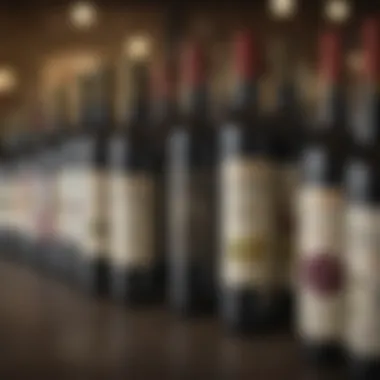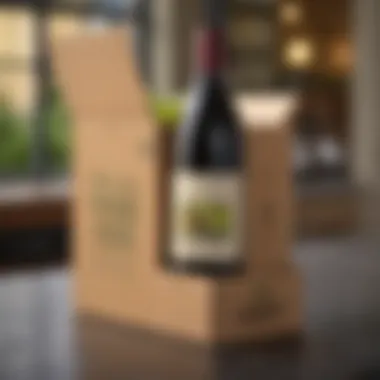Whole Foods Wine Delivery: Services & Insights


Intro
The exploration of Whole Foods' wine delivery options unveils a unique intersection of convenience and quality, catering to consumers who appreciate fine wines without the need to venture out. Understanding the policies, availability, and user experiences associated with this service provides insightful perspectives for potential customers. Whole Foods, known for its emphasis on organic and wholesome products, expands its approach to wine delivery, aiming to enhance the shopping experience for a discerning clientele.
Availability of Wine Delivery Services
Whole Foods' wine delivery service is accessible through platforms like Amazon Prime Now. This partnership allows customers to order wines from their local Whole Foods store and receive them at their doorstep, often on the same day. Availability may vary depending on geographic regions and local laws regarding alcohol delivery.
- Coverage: The wine delivery option is available in various cities across the U.S., primarily in metropolitan areas.
- Hours of Operation: Delivery windows may differ. Customers should check specific store hours and order delivery slots to ensure timely service.
It is crucial for customers to be aware of the age restrictions and maintain proper identification during delivery for compliance with local regulations.
Product Range
When it comes to wine selection, Whole Foods offers a broad variety of options, from domestic to imported wines. Customers can expect categories such as red, white, sparkling, and rosé, along with organic wine selections that align with the store's overall philosophy.
Some key points include:
- Types of Wines: Merlot, Cabernet Sauvignon, Chardonnay, and Pinot Noir are just a few examples present in their inventory.
- Sourcing: Many wines are sourced from sustainable vineyards, which appeals to environmentally-conscious consumers.
User Experience and Feedback
The user experience with Whole Foods' wine delivery is generally positive, particularly regarding convenience and selection. Customers have reported satisfaction with the promptness of delivery and the quality of the wines received.
- Ratings: Users often comment on the ease of the ordering process through the app and the satisfactory level of customer service.
- Complaints: Some concerns arise regarding limited selection in certain areas or instances of stock shortages.
Regulatory Considerations
The regulatory landscape for alcohol delivery can be complex. Different states have varied laws governing the sale and distribution of alcohol. Whole Foods adheres closely to these regulations, ensuring compliance in all its delivery practices. This compliance is essential not only for legal reasons but also for building trust with customers.
Comparison with Other Retailers
Whole Foods' approach to wine delivery can be contrasted with offers from other retailers like Total Wine or BevMo. While both alternatives provide extensive wine selections, Whole Foods distinguishes itself through its focus on organic options and sustainability.
Factors for Comparison:
- Delivery Fees: Whole Foods generally has competitive pricing compared to other retailers.
- Quality Assurance: Whole Foods emphasizes quality over quantity in its offerings.
Understanding Whole Foods and Its Delivery Services
The rise of online shopping has reshaped the landscape of retail. Whole Foods, a prominent player in the grocery market, has adapted its services to meet this demand. Understanding Whole Foods and its delivery services is crucial for consumers who seek convenience and quality in their shopping experience. This exploration highlights key aspects, including how Whole Foods has grown over time and the delivery options available to customers.
The Evolution of Whole Foods
Whole Foods began its journey in 1980 as a small natural foods store in Austin, Texas. Over the years, it has evolved into a massive grocery chain, recognized for its commitment to organic products and sustainability. In 2017, Amazon acquired Whole Foods, a move that brought significant changes to its operational model. This acquisition integrated Whole Foods with Amazon’s extensive logistics network. As a result, customers can now access a wider range of products, including premium wines, from the comfort of their homes. The impact of this evolution is noticeable in how Whole Foods emphasizes both quality and convenience in its offerings.


Overview of Delivery Offerings
Whole Foods provides several delivery options designed to cater to different customer needs. These services include:
- Same-Day Delivery: Customers can order items online and receive them within hours. This is particularly effective for those who need last-minute supplies or wish to enjoy wine with dinner.
- Amazon Prime Now: For Prime members, Whole Foods offers delivery through the Amazon Prime Now app. This service allows shoppers to order a variety of products, including wine, and have them delivered quickly.
- Curbside Pickup: This option enables customers to shop online and pick up their orders at a designated location. It provides a balance between convenience and the experience of visiting the store.
- Regular In-Store Shopping: For those who prefer a traditional shopping experience, Whole Foods continues to maintain its brick-and-mortar stores, where customers can browse and shop for wine and other products directly.
Understanding these delivery options helps consumers make informed decisions about how to purchase wines and groceries in a way that aligns with their lifestyles. Whole Foods has truly embraced technology to facilitate a seamless shopping experience.
Wine Selection at Whole Foods
The selection of wines at Whole Foods plays a vital role in enhancing the overall wine delivery experience. Wine is often more than just a beverage; it represents culture, tradition, and personal preference. Thus, Whole Foods' commitment to offering a diverse and high-quality wine selection is significant for many customers. When considering wine delivery, customers typically look for variety, quality, and accessibility. Whole Foods aims to meet these expectations by providing a range of wines that cater to various tastes, occasions, and price points.
Whole Foods emphasizes organic and sustainable practices in sourcing their wine selections. This aligns with the brand's overarching commitment to health and environmental responsibility. By choosing Whole Foods, customers often feel they are making a choice that supports ethical production and quality. With this in mind, let's explore the two main aspects of Whole Foods' wine offerings: the types of wines available and their specialty or local selections.
Types of Wines Offered
Whole Foods ensures a comprehensive selection of wines, featuring varietals that range from popular classics to more obscure options. The following reflects some of the types of wines offered at Whole Foods:
- Red wines: A variety that includes well-known options like Cabernet Sauvignon and Merlot, alongside lesser-known varietals such as Tempranillo and Barbera.
- White wines: Featuring popular choices like Chardonnay and Sauvignon Blanc, as well as unique offerings like Viognier and Grüner Veltliner.
- Rosé wines: A refreshing selection that varies seasonally and includes both sweet and dry options.
- Sparkling wines: Varieties such as Champagne and Prosecco, along with other bubbly styles.
- Fortified wines: Ports and Sherries that provide a rich and complex drinking experience.
Whole Foods continuously updates its inventory, adapting to customer preferences and trends. This focus on variety allows customers to experiment and discover new favorites, encouraging a more enriching wine experience.
Specialty and Local Selections
Whole Foods often showcases a range of specialty and local wines that distinguish their offerings from peers in the market. This is essential for customers who prefer to support local producers. Some key highlights include:
- Local wineries: Whole Foods partners with various regional wineries, giving customers access to unique wines that come from their own communities. This not only supports local economies but also promotes a sense of connection between consumers and producers.
- Organic and biodynamic wines: The brand highlights selections that are produced using organic practices. These wines often appeal to health-conscious consumers who seek products without pesticides and synthetic additives.
- Limited editions: Occasionally, Whole Foods features seasonal or limited-release wines. These exclusive selections can create excitement and encourage customers to explore their wine options more closely.
Having a diverse selection of wines available, especially with a focus on local and specialty options, significantly enriches the customer's shopping experience. This allows Whole Foods to position itself as a destination for both wine enthusiasts and casual drinkers looking to enjoy something new.
Delivery Processes and Logistics
The delivery processes and logistics of Whole Foods' wine delivery services play a crucial role in the overall customer experience. Understanding how these systems operate helps consumers appreciate the reliability and efficiency of their wine purchasing options. A transparent and well-organized delivery system minimizes frustrations for customers and enhances satisfaction, making it essential to investigate how Whole Foods manages these processes.
The benefits of examining delivery logistics are multi-faceted. Primarily, this analysis allows consumers to foresee potential hurdles and plan their purchases accordingly. For instance, understanding timeframes for delivery can help in ensuring that customers have their wines available for special occasions or regular gatherings. Additionally, an efficient delivery network can also enhance the selection and access to wines, providing customers with a broader range of choices than might be available in-store.
Step-by-Step Delivery Experience
Whole Foods strives to ensure that the delivery experience is straightforward and user-friendly. Customers start by ordering online or through the app. First, they browse through the selection of wines offered, which is categorized for easier navigation. Once the ideal choices are made, customers place their orders, entering their delivery information.
After the order is confirmed, the next step involves a confirmation email that includes details such as estimated delivery time and tracking information. It is at this stage where a customer can manage their delivery preferences or make adjustments. The final stage is when the delivery driver arrives at the specified address, at which point the customer may need to verify their age as required by law.
An aspect that adds to the convenience of the process is the possibility of choosing a delivery window that best suits the customer’s schedule. Subsequently, Whole Foods aims for timely deliveries while also ensuring that packages are handled with care to prevent damage to the wine bottles.
Areas Covered by Delivery Service
Whole Foods has developed strategic logistics to extend their delivery services across various regions. However, coverage is not uniformly available nationwide. The areas that can be serviced include metropolitan regions and suburban neighborhoods where demand for wine delivery has been the highest.


It’s important for customers to verify whether their specific location falls within the delivery network. Typically, customers in areas such as New York City, Los Angeles, and Chicago will find Whole Foods' wine delivery more accessible compared to those in rural areas. This geography of service is essential for customers to consider in their purchasing decisions.
In summary, Whole Foods continually refines its delivery processes and logistics, focusing on providing a seamless experience for customers throughout the ordering and delivery stages. Understanding these systems allows consumers to make informed choices and appreciate the convenience that Whole Foods' wine delivery services offer.
Customer Experience and Feedback
Understanding customer experience and feedback is vital in evaluating Whole Foods' wine delivery services. The satisfaction level of customers can greatly influence the retailer’s reputation and impact future business decisions. Engaging with clients' thoughts and concerns allows Whole Foods to optimize its services to better fit consumer expectations. Feedback can highlight strengths and expose weaknesses in delivery processes, guiding Whole Foods to refine their offerings continually.
A positive customer experience can also lead to increased loyalty and repeat business. When shoppers are pleased with their purchases, including selection and delivery efficiency, they tend to return. Feedback helps potential customers assess the reliability of Whole Foods for wine delivery.
Moreover, analyzing user reviews provides insight into trends and consumer preferences. Understanding what customers like or dislike can inform Whole Foods about potential areas for expansion or improvement.
User Reviews and Testimonials
User reviews and testimonials provide a firsthand account of what customers expect and experience when ordering wine from Whole Foods. Many customers have expressed their satisfaction with the range and quality of the wines available. Reviews often mention how easy it is to navigate the online store, simplifying the shopping process.
Additionally, specifics about delivery speed and packaging quality are commonly discussed. For instance, several customers have praised Whole Foods for ensuring that their orders arrive promptly and in excellent condition. This attention to detail can elevate customer satisfaction.
However, some reviews point out issues such as limited availability in certain regions.\nThese insights are critical for prospective buyers to make informed decisions.
Common Issues and Resolutions
Every service may encounter challenges. In the realm of wine delivery, whole foods is no exception. Common issues include delays in delivery and stock shortages. Such problems can disrupt the customer's experience and dilute trust in the service.
Whole Foods has made efforts to address these concerns. For instance, if an order is delayed, the customer service team often reaches out quickly to offer solutions or alternatives. They also tend to provide refunds where applicable, showing commitment to customer satisfaction.
Another issue is the age verification process, which some customers find cumbersome. However, this process protects both the retailer and the consumers, ensuring compliance with legal regulations. Continuous tweaking of this procedure based on customer feedback can lead to a smoother experience.
By actively engaging with customers and addressing their issues, Whole Foods can strengthen its service quality and deepen customer loyalty.
"Customer feedback is not just data; it is essential for enhancing service quality and customer experience."
Thus, maintaining an open dialogue with customers regarding their experience, collecting feedback, and responding effectively to the problems they face is crucial for Whole Foods' long-term success in the wine delivery market.
Comparative Analysis with Other Retailers
The comparative analysis with other retailers plays a crucial role in understanding Whole Foods’ position in the ever-evolving landscape of wine delivery services. This section assesses how Whole Foods measures up against its competitors, exploring key factors that influence consumer choice. Retailers today offer diverse services, but not all wine delivery options are equal. Understanding these differences can help consumers make more informed decisions when purchasing wine online.
Whole Foods vs. Competitors
Whole Foods has carved out a unique space in the wine delivery market. The store's commitment to quality and organic products provides a distinct edge. Compared to competitors like Total Wine & More, BevMo!, and even traditional grocery chains like Kroger, Whole Foods emphasizes a carefully curated selection. They focus on organic wines, sustainable practices, and local offerings. These attributes appeal to a health-conscious audience, ensuring that the products align with their values.
Moreover, while many retailers depend on lower pricing strategies to drive sales, Whole Foods maintains a premium image, often justifying higher prices with better quality and selection. Additionally, Whole Foods' integration with Amazon has enhanced its delivery capabilities. Customers can access a broader network and potentially faster shipping options owing to Amazon's infrastructure.
Here are several points of comparison between Whole Foods and its competitors:
- Quality of Products: Whole Foods prioritizes organic and natural wines, whereas some competitors may offer a broader palette, including mass-market selections.
- Customer Experience: Whole Foods often ranks higher in customer satisfaction due to its focus on store experience and knowledgeable staff compared to many online-only retailers.
- Delivery Options: Whole Foods benefits from Amazon's delivery system, allowing for both scheduled and same-day deliveries in select areas, a feature less common with competitors.
- Pricing Structure: Whole Foods typically has competitive prices in its niche but may seem higher when compared to discount-focused retailers.


Unique Selling Points of Whole Foods
Whole Foods' wine delivery service features several unique selling points that set it apart from other retailers. These points are essential for discerning consumers looking for specific qualities in their wine purchases.
- Sustainability: Whole Foods champions sustainable practices which include sourcing from vineyards that employ eco-friendly methods. This factor resonates well with environmentally conscious consumers.
- Local Selection: Whole Foods highlights local wineries and crafts wine selections that support regional producers. This angle not only enhances customer loyalty but also promotes the local economy.
- Expert Staff Advice: Unlike many competitors, Whole Foods often employs knowledgeable staff who can provide personalized recommendations based on seasonality, food pairings, and customer preferences. This personalized service can enhance online purchasing through consultation options.
- Health-Conscious Offerings: The focus on organic and biodynamic wines appeals to a demographic that prioritizes health and wellness, an important consideration for a segment of the modern consumer base.
Whole Foods effectively combines quality and accessibility, a rare equilibrium in the present marketplace for wine delivery.
Overall, understanding how Whole Foods positions itself in relation to other retailers helps consumers leverage their wine purchasing decisions. The strengths highlighted emphasize Whole Foods as a reliable and responsible choice for wine delivery.
Legal and Regulatory Considerations
Understanding the legal and regulatory landscape surrounding wine delivery is critical for both consumers and retailers. This section will shed light on the various rules governing wine sales and deliveries which have significant implications for Whole Foods and its customers. Compliance with these regulations ensures the legitimacy of services offered, offering reassurance to consumers about the safety and legality of their purchases. Additionally, these laws can influence the accessibility and availability of products, which impacts consumer behavior.
State Regulations on Wine Delivery
State laws play a central role in shaping the framework for wine delivery services. Each state has its specific regulations that dictate how alcohol can be sold and transported. For instance, states like California have more permissive laws regarding wine delivery compared to others such as Utah, which impose strict restrictions.
This patchwork of regulations presents challenges for consumers who wish to take advantage of delivery options. Customers need to be aware of their state's specific rules concerning the sale of alcoholic beverages, including age restrictions for purchasers and delivery drivers.
Whole Foods must navigate these various regulations to ensure compliance, which can sometimes affect product availability in certain areas. It is important for consumers to check if their state allows for wine delivery from retailers like Whole Foods to avoid potential disappointments.
Restrictions on Alcohol Purchases
Restrictions on alcohol purchases encompass a range of factors that affect both retailers and consumers. Firstly, there are age restrictions which typically require consumers to be at least 21 years old to purchase alcohol. Whole Foods must enforce this law strictly, often requiring identification at the time of delivery.
Furthermore, there are limits to the quantity of alcohol that can be purchased in one transaction, varying by state. These limits are in place to prevent bulk buying and possible misuse of alcoholic beverages. Whole Foods adheres to these regulations, which may mean that while ordering, consumers will face restrictions on the number of bottles they can buy in a single order.
Additionally, retailers need to consider local laws that may impose stricter regulations beyond state rules. This can include zoning laws, which dictate where alcohol can be sold, and local ordinances that may restrict delivery services altogether.
Key insights: Awareness of local and state laws is vital. For consumers, understanding these restrictions can help mitigate disappointments and concern regarding the legality of purchases.
Impact of Delivery Services on Consumer Behavior
The impact of delivery services on consumer behavior represents a significant shift in how individuals engage with retail, particularly in the realm of wine purchases. Wine delivery options provided by Whole Foods have not only made access easier but have also transformed traditional buying habits. Understanding this impact is essential for consumers looking to navigate this changing landscape effectively.
Trends in Online Wine Purchases
The rise of e-commerce has influenced purchasing trends across various sectors, including the wine market. Consumers increasingly prefer online platforms due to several factors:
- Convenience: The ability to browse and order from home eliminates the need to visit physical stores. Shoppers can explore a vast selection of wines without time constraints.
- Variety: Online wine retailers offer extensive collections that far exceed what could be found locally. This diversity allows consumers to discover new and unique wines.
- Information Access: Detailed product descriptions, user reviews, and expert ratings online empower consumers to make informed decisions.
Recent studies indicate a notable increase in online wine sales. More consumers are comfortable purchasing wine through delivery services. This convenience appeals particularly to busy professionals and younger demographics seeking new experiences.
Changing Preferences among Consumers
Consumer preferences around wine purchases are evolving. Several factors contribute to this shift. Firstly, as society becomes more health-conscious, many individuals are turning to organic or biodynamic wines. Whole Foods takes note of these inclinations, adjusting offerings to meet the demand for healthier and sustainable options.
Additionally, the immediacy of delivery services caters to an instant gratification mindset. More consumers desire their purchases swiftly. According to surveys, instant delivery options can create strong brand loyalty.
- Personalization: Customers also appreciate tailored recommendations based on their previous purchases. This aspect not only enhances the shopping experience but encourages repeat business.
- Social Influence: Wine purchases are increasingly influenced by social media and peer recommendations. The visibility of wine-related content, particularly on platforms like Instagram and Facebook, shapes consumer choices.
"The convenience of wine delivery services has set new standards in consumer expectations."



